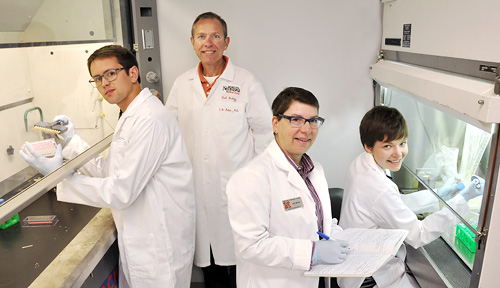Each human is chronically infected with up to 10 viruses at some time in life.
Two of the most common: the Epstein-Barr virus, which causes mononucleosis, and the recently discovered Saffold virus, which causes early childhood infection.
 |
The UNMC/UNL viral immunology collaborative team at work in Dr. Petro’s lab at the UNMC College of Dentistry. From left, Ph.D. student Tyler Moore; Tom Petro, Ph.D.; Deb Brown, Ph.D.; and research technician Elizabeth Cody. |
The method
To do so, the professor of microbiology and immunology at the College of Dentistry began to investigate the role played by the interferon regulatory factor 3 (IRF3) gene, which is expressed in macrophages, the immune system’s first line of defense to viral infection.
He used two mouse models — one that is naturally susceptible to macrophage infection by Theiler’s Murine Encephalomyelitis Virus (TMEV), which is related to Saffold and can cause chronic inflammation in the brain, a condition that closely resembles multiple sclerosis in humans. The other model is resistant to chronic infection of the virus.
He infected them both with TMEV and found that the IRF3 response was dysfunctional in the mouse susceptible to infection and found the genetic basis for the difference in IRF3 behavior.
“I believe this contributes to its natural susceptibility to TMEV,” Dr. Petro said.
A search partner
By now Dr. Petro was in collaboration with Deb Brown, Ph.D., assistant professor at the School of Biological Sciences at the University of Nebraska-Lincoln and a viral immunologist at the Nebraska Center for Virology. Dr. Brown’s reviewers on grants and papers wanted to see if her findings with the influenza virus also were valid for other viruses — like TMEV.
“The collaboration made sense,” Dr. Petro said. “There are so few immunologists at UNL, and at UNMC for that matter, that collaboration is a necessity.”
Progress could lead to breakthroughs
They received a seed grant from the Nebraska Center for Virology to foster collaboration science. The team has two joint publications and is at work on a third manuscript.
Together, their work may give insight into the cause of chronic viral infection and perhaps even multiple sclerosis in humans.